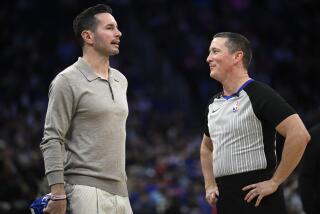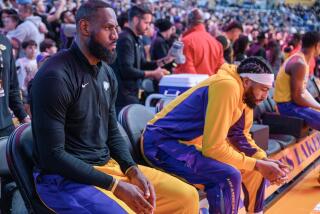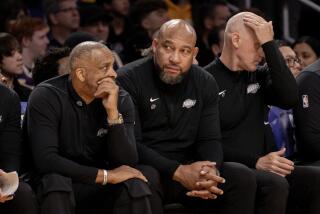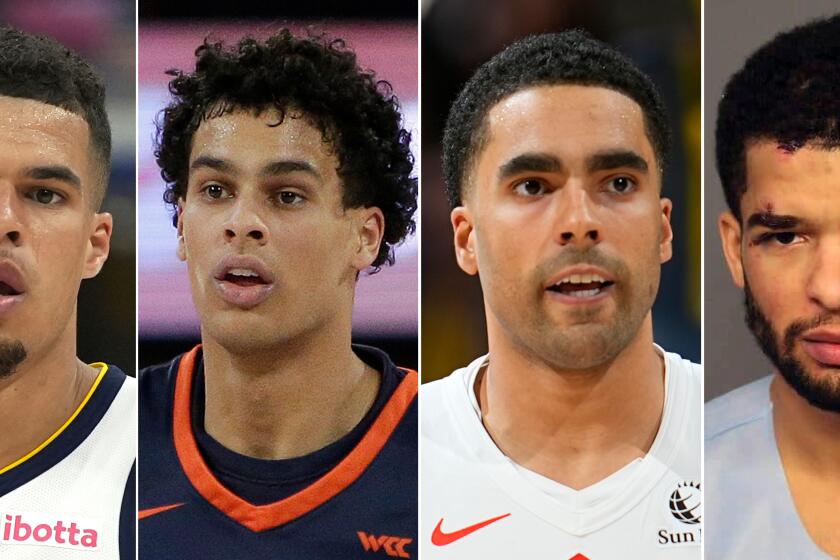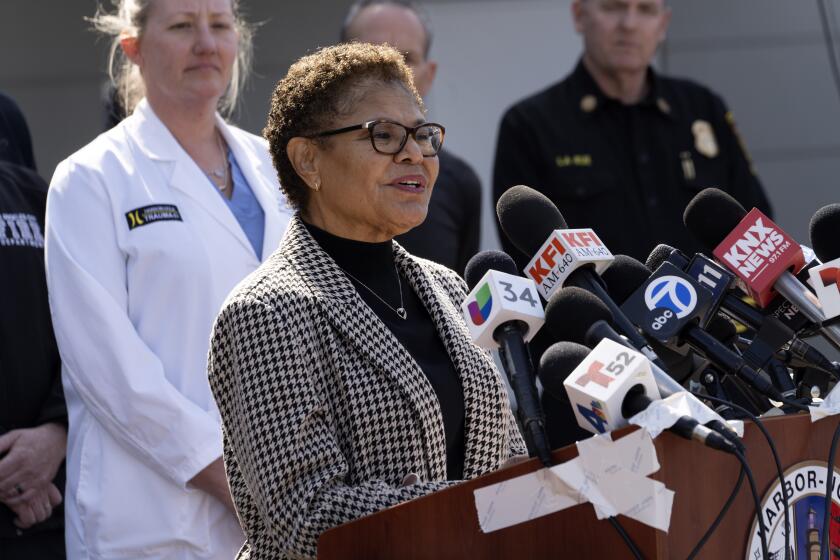65,000 Angelenos can’t be wrong
Despite 1,000 police officers in riot gear, rowdy fans celebrating their team’s championship overturned cars, set fires, broke windows and vandalized stores. A car was torched, 16 people were injured, a police officer suffered a broken nose when someone threw something at him from the crowd.
That wasn’t Los Angeles last Thursday night. It was Boston in 2004, when the Red Sox clinched the American League championship and baseball fans rioted in the streets around Fenway Park.
The post-game violence outside Staples Center last week was ugly, disgusting and wrong, a discordant coda to what should have been a shining celebratory moment.
But it’s not unique to Los Angeles or to basketball. And it’s not the fault of true Lakers fans — like the estimated 65,000 who turned out Monday for the Lakers’ championship parade.
---
I’m taking a lot of heat from readers for suggesting in my Saturday column that a communal viewing of last week’s championship game might have made for a more peaceful evening last Thursday.
Some thought I wasn’t tough enough on the troublemakers, or that I didn’t give enough credit to Los Angeles police officers.
“Make no mistake,” wrote LAPD Assistant Chief Michel Moore, “it was our men and women in law enforcement and fire who stepped forward and stopped the violence and riotous acts.”
Moore has seen enough over the years to believe that violence is endemic to sports celebrations, that “there exists a core group of thugs and hooligans who won’t be satisfied with the simple elation of a hometown win.”
A Jumbotron won’t help, he said, and might make things worse.
But I heard from other readers who think the city could score big by providing for Lakers lovers who aren’t ticket holders.
“Why not a public viewing of the game on a large screen at Pershing Square, which could have been open to the public?” wrote Cary Brazeman. “Or a viewing at the Convention Center, maybe as a charity fundraiser for, say, five bucks a head?”
Charles Edelsohn suggested that a post-game show broadcast live on giant screens might have entertained the crowd outside Staples Center until emotions calmed.
Add a concert and allow “our photogenic mayor to continue to extol his virtues in two languages,” said the retired rocket scientist. And send the show “out via the Internet to the many digital billboards now blighting our suburbs.”
“What a missed opportunity for city and countywide unification,” he wrote.
But there were party poopers as well in my inbox crowd. Karen Cozzolino said she’d rather “stay in my nice living room with good friends and family” than risk being robbed, groped or cursed out.
“I wouldn’t mind a bit if the Lakers pulled a midnight move out of L.A. like the Rams and Raiders did,” she wrote. “No public ‘celebrations.’ No riots.”
In other words, the team might be more trouble than it’s worth.
---
Tell that to the 65,000 people who spent hours along the parade route, waiting for the Lakers truck to roll by. People drove in from all over the city and as far away as Visalia and Victorville and camped out overnight for no more than a glimpse of their stars. And their only complaint was a shortage of toilets.
I think civic leaders underestimate what the Lakers mean to this town. The toilets weren’t delivered until Monday morning, because city officials had no idea, said Councilwoman Jan Perry, that people would line up the night before.
Asked why they did, the fans answered simply, again and again: I want to see Kobe. Or Fisher. Or Pau.
These were fans who have never been inside Staples Center, never seen their heroes in person. Never — as one little girl who waited three hours before the parade told me — “seen Kobe really alive.”
It’s not just that the Lakers are athletes, or even celebrities. They are symbols of pride, which we need right now.
The team is one of the few things we can unite behind in a city that functions at its worst as an unrelated collection of neighborhoods, and its best as a family of bickering siblings, fighting over the last slim slices of a shrinking pie.
Parade organizers got it right. Instead of trying to pack a million people in a Coliseum that holds 90,000 — guaranteeing that some will be left out — they skipped the rally in favor of one two-mile homecoming party, with room for all.
The goodwill that rooting together for the home team generated is a plus for us. A recent national study shows that what makes people love where they live is the sense of “belonging.” And cities where people feel connected tend to prosper economically.
Before next year’s championship rolls around, I hope our civic leaders take note. Maybe that outpouring of Lakers love can be harnessed to run the troublemakers off.
More to Read
All things Lakers, all the time.
Get all the Lakers news you need in Dan Woike's weekly newsletter.
You may occasionally receive promotional content from the Los Angeles Times.
